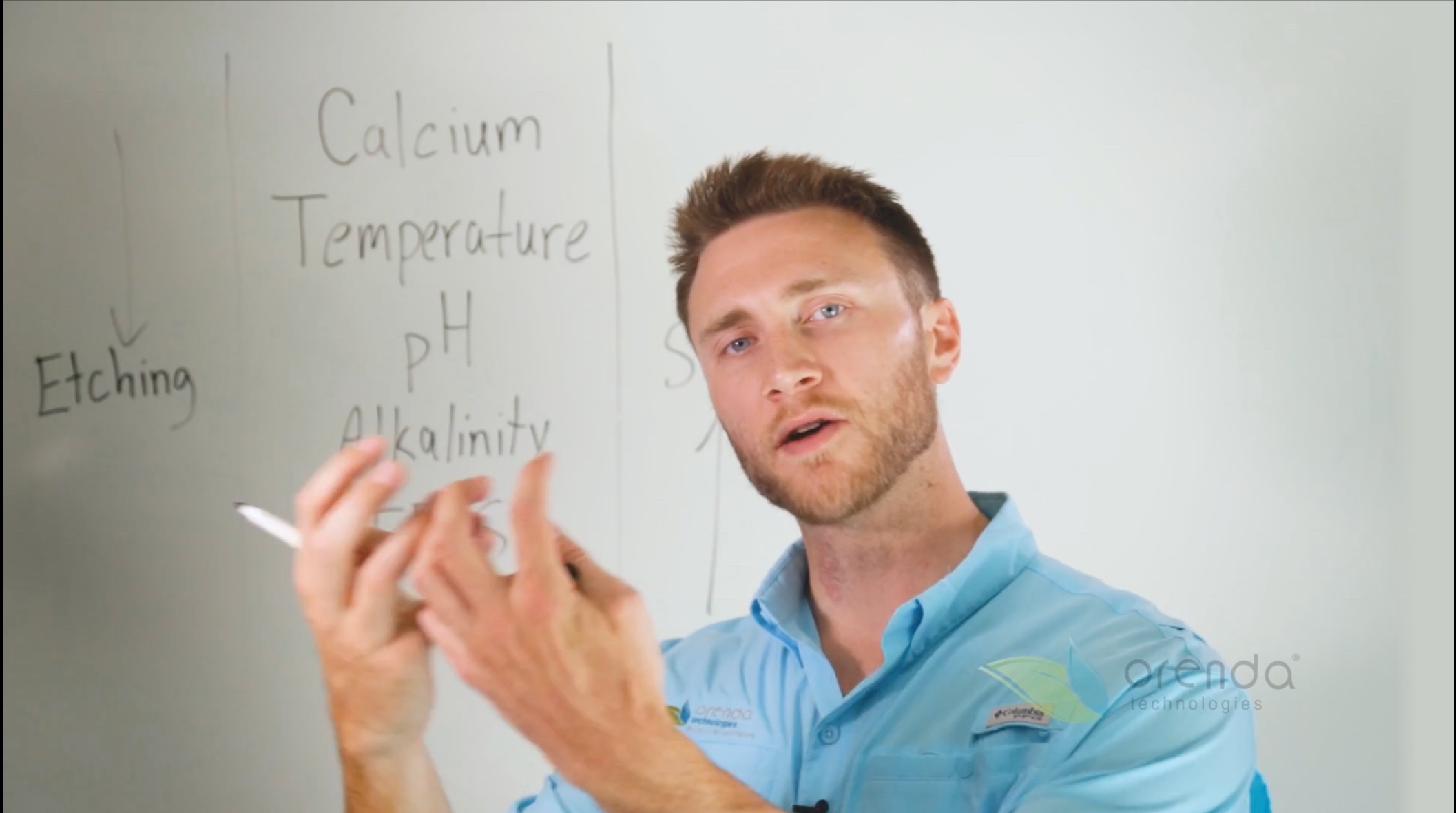Author Archives: vlm
A Family’s Space for Outdoor Living in Media, PA
Chris Volk worked with the Cilli family to develop a luxury outdoor living space at their home in Media, PA where the focus is water.
“When we started looking for an opportunity to spread out,” Darryl Cilli said, “we knew it wouldn’t be easy, but it had to be in Media.” The town they’d called home for 20 years is just three-quarters of a square mile, 12 miles west of Philadelphia on a high plateau in the center— hence the name “Media” for “in the middle”—of Delaware County.
There were few large lots available, but they finally found a remodeled farmhouse situated on three-plus acres. They moved in with their two boys, then 9 and 12, at the end of 2019.
The lot’s steep slope at the rear of the property presented a challenge for expanding the house and building their outdoor living spaces. It would take another 24 months of careful planning, coordination, and skilled execution to achieve their dream. Cilli gives credit to the exceptional team he put together—architect, builder, pool and spa design/build group, and tennis court builder.
He said each team member is an expert in his field and showed respect for the skills and special knowledge of the other team members. The result is a house that flows from house to deck and patio, to pool, to pool house, and on down to tennis court on a lower level. It all fits together in modern, comfortable style, set in a landscape that delights the senses.
The WaterSpace
Pool and Spa occupy prime space in the overall plan, setting the stage for all you see and all that happens in the outdoor living area. “Chris Volk isn’t just your usual pool contractor,” Cilli said. “He’s an excellent designer. He nailed the location—where he sited and oriented the pool, where he located the pool’s infinity edge.”
And then there’s the spa. “Chris elevated the spa, so it rises from the pool, with its own infinity edge. When you sit in the spa you’ve got the best view of all.”
“He’s an artist,” Cilli added. “You can see it in how he picked the perfect tile for the spa. His choice of materials throughout the area adds just the right texture and contrast.” You can also experience the art of design in the placement of what the family calls “the little house.” It sits beside the pool, with pocket glass doors that open wide, merging indoor and outdoor spaces into a complete outdoor living experience.
Nighttime Transformation
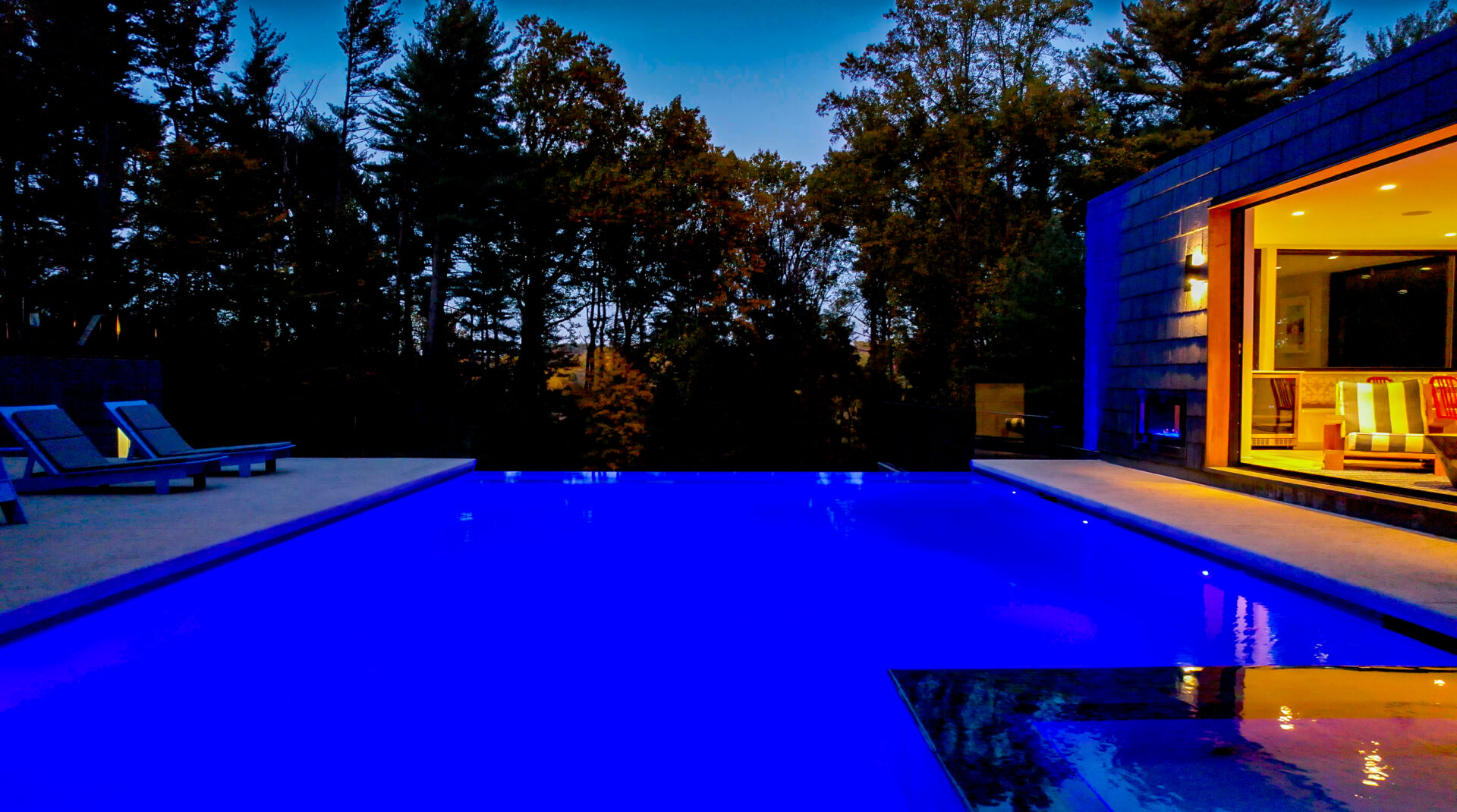
Everywhere you stand or sit, everywhere you look in this WaterSpace, your eye finds something that delights, surprises, and continually changes as each day progresses. When night falls, the entire space surrounding the pool is bathed in light, reflected in falling water and accompanied by dancing fires.
“The lighting Chris designed is amazing,” Cilli said. “It’s the best surprise of the whole project. I didn’t anticipate how the lighting would cast lines and reflections on the architecture. It transforms the pool. The spa. The waterfall basin.”
A Passion for Function and Details
Darryl Cilli found Volk equally passionate on the mechanical and construction side of the luxury pool business. “The guy is essentially an engineer,” he said; especially when it comes to making the best mechanical and construction choices.
For example, Cilli said he had favored a salt system to sanitize pool water, but Chris recommended Ozone. He cautioned that in the long run salt would lead to problems for the infinity edge pool and spa. “It turned out the Ozone system is one of the best moves we made,” Cilli said. “It’s like swimming in fresh water.”
Maintaining the Vision
When it comes to Luxury Design/Build pools and spas, a third—often overlooked—challenge comes with maintaining your WaterSpace. Many potential maintenance problems can be anticipated and avoided, as in the selection of an Ozone rather than saltwater treatment system. Other things need never become a problem when the builder has the resources to provide competent water and pool maintenance services.
But when something happens, as Darryl Cilli points out, that’s when you learn more about the quality of your builder. “Chris is great about coming back and fixing the little things that crop up and showing up in a hurry if something unexpected happens,” he said. “It’s a level of service beyond what’s expected.”
Outdoor Living with a Vision
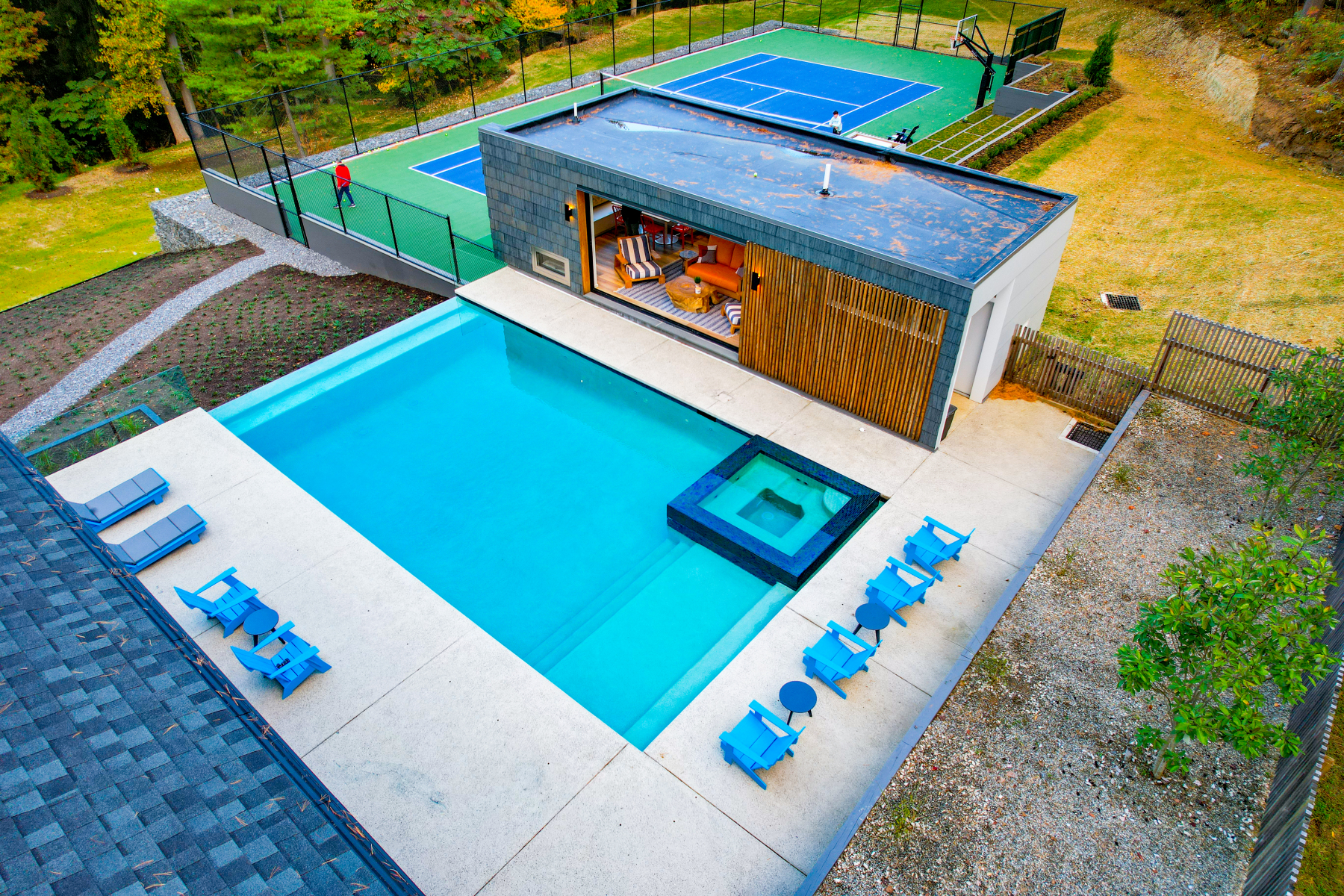
Both sons play tennis and take lessons. They train and play for fun at home with their father, who was a seeded champion in high school and college. After play, everyone can cool off in the pool, or just hangout poolside and in the air-conditioned little house. There’s a TV, refrigerator, food and drinks, sofa, table, and chairs, even a Murphy bed for overnight guests.
And then there are the views. You’ll never tire of the views: The water falling from pool and spa. The changes of the seasons, The daily change from light to dark. The lights. The fireplace in the little house and fire table on the deck, casting light in the dark and warming cool nights.
Beyond the fine view from the spa, there’s the relaxing, therapeutic jets and warm water, a space shared with family and friends. “You just feel amazing,” Cilli said. He said the pool is heated so it can stay open until after Christmas. Heating the water also lets the family reopen early in April, ready to enter another season of outdoor living, just as envisioned.
How Modern Art Brought Us Today’s Hottest Pool Designs
Modern style is the hottest design trend in swimming pools and outdoor living spaces. It’s a style with deep roots in Twentieth Century Modern art. You can see how Henri Matisse contributed to the development and spread this modern style in three museum visits: “The Dance” (1933) at the Barnes Foundation in Philadelphia, “The Swimming Pool” (1952) at the Museum of Modern Art in New York (MoMA), and now through January 29, 2023, “Matisse in the 1930s,” a special exhibit at The Philadelphia Art Museum (PAM).
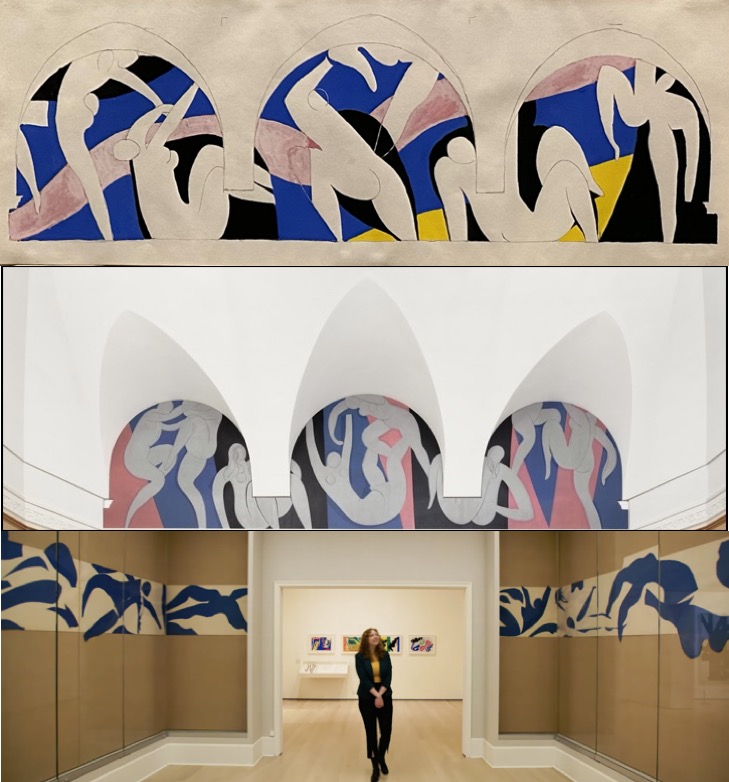
MODERN STYLE—Top: “Dance: Study for the Barnes Mural (Second Version)” on loan from the Metropolitan Museum of Art to ”Matisse in the 1930’s,” a special exhibit currently at The Philadelphia Art Museum. Middle: “The Dance” by Matisse, at The Barnes Foundation. Bottom: “The Swimming Pool” by Matisse, at the Museum of Modern Art.
A Philadelphia Start
This Modern art story and your museum visits start in Philadelphia. If you go before January 29, start with the PAM exhibit. It puts the entire saga of Matisse’s visit to Philadelphia into context. The exhibit takes us from his earlier work to that fateful visit in 1930, where Albert Barnes changed the arc of his career, to the remarkable works that followed in one remarkable decade.
An Introduction to The Dance
With a commission to create a mural for the Barnes Foundation, Matisse was inspired to make something that hadn’t been done before. He named it “The Dance,” and the show includes an extensive collection of conceptual drawings, paintings, photos—even a movie—that document the mural’s creation and the influence it had on the work that follows.
Matisse had to work on a monumental scale to fill a space some 45 feet wide and 17 feet high. To expedite the design process, he created full sized, pre-colored cut papers to position and re-position the images that would dance across the Barnes wall. This cut paper expedient would evolve into an art form that distinguishes much of his later work.
Movement in Art and Architecture
We’ve covered in previous articles the essential role of visual movement, and how “straight lines, curves and angles create a sense of movement in our minds.” It’s one of the six principles of design in landscape architecture. Pleasing outdoor spaces make artful use of line and other basic design elements, such as shape, color and texture, to bring movement to life. It’s the seeing—really the sensing or feeling—of movement that invites us to stay and explore a space.
The works in the exhibit’s “Artist and Model” section demonstrate Matisse’s progression toward more abstract figures. With “The Dance,” bodies are translated into flat shapes seeming to dance across canvas and walls. In another section, “A Mural in Motion,” Matisse goes on to create designs for the dance itself. You can watch a film and see the costumes, stage curtain, and backdrop he designed for Ballets Russes de Monte-Carlo. Note how the backdrop is topped by three great vaults, much like the space at the Barnes where “The Dance” is installed.
Movement Captured in Matisse’s Swimming Pool
The heat was too much for a man his age. So, in the summer of 1952, Henri Matisse left the swimming pool he often visited in Cannes. Returning home to Nice, he announced he would “make myself my own pool.” He then captured in paper cutouts his memories of pool and swimmers. He set his pool in place on his dining room walls, in stationary, two-dimensional space; yet filled with magical blue shapes, floating, swimming, and sometimes breaking free of the imaginary pool’s straight edges.
In this brief YouTube video, MoMA’s Josephine McReynolds reflects on Henri Matisse’s “Swimming Pool” and how the work evokes thoughts of childhood and long days of play in a swimming pool.
After his death in 1954, the “The Swimming Pool” eventually made its way to New York, where it was recently restored at MoMA and is a part of its Permanent Collection. Now, 70 years after its creation, “The Swimming Pool” and the Modern design Matisse embodied continue to resonate with us because, well, it still feels so modern. You can jump into Matisse’s pool in The David Geffen Galleries, located on MoMA’s 4th Floor, room 406.
Plunge Pools and Swim Spas: Luxury Pools Go Small
Make (Less) Room for these Little Pools (plunge pools) that Turn Small Yards into Posh Daily Retreats
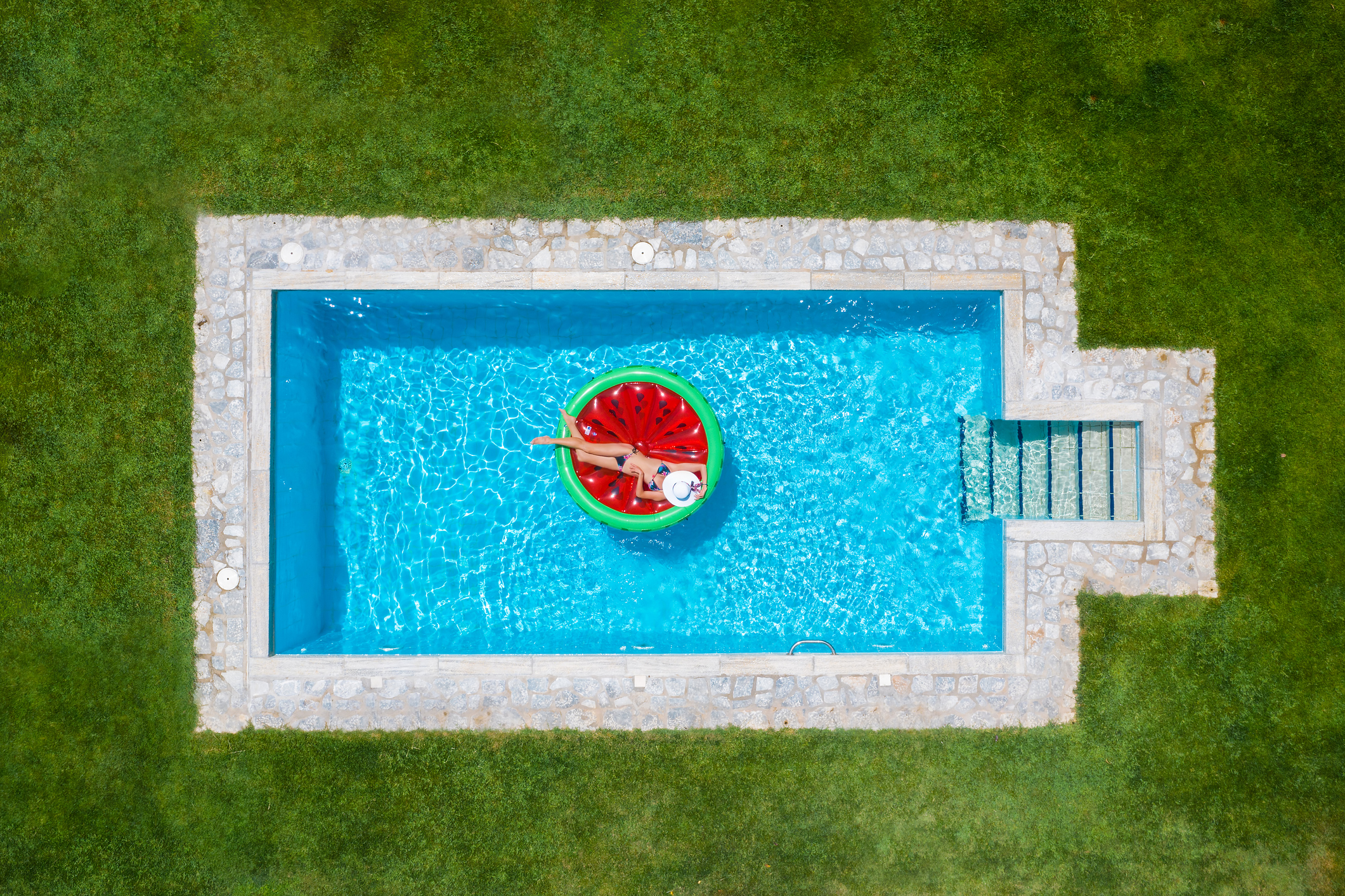
Going Small: Homeowners are discovering the practical and luxurious benefits of small plunge pools
When The Wall Street Journal announces plunge pools are, “A Chic Swimming Pool Alternative for Small Backyards,” and a week later The New York Times publishes a plunge pool story, “Don’t Call It a Swimming Pool,” you know small pools are now the hottest trend in home pools.
Allison Duncan at The Wall Street Journal calls the plunge pool, “An elegant compromise between a yard-usurping swimming pool and a Nemo-themed kiddies ‘inflatable’.” New York Times reporter Lila Picard says plunge pools “have become an alternative for homeowners who want a simple, less expensive way to cool off.”
Chic Small Pools
You may have seen an article we published in January 2021 on “The Joy of Small WaterSpaces.” That story was prompted by the rush to add a new home spool or cocktail pool during pandemic lockdowns. Some of these pools were quick DYI projects using stock pools—repurposed plastic or steel water troughs for livestock. Our focus was on homeowners who opt for a more lasting, luxurious alternative: “People with smaller lots want to get out of the house without leaving home,” we observed, “and a small WaterSpace is the answer they’re looking for.”
This Covid-driven staycation moment has grown into a full-blown plunge pool movement. It’s a smart move for homeowners looking for a smaller, easier, more efficient way to enjoy a luxury resort experience in their own homes. It’s a great solution for small or odd shaped lots that can’t fit a standard swimming pool. It’s an equally attractive option for for those with large spaces to create or add to their unique WaterSpace.
Hot and Cool Plunge Pools
Think of these cool new plunge pools as a slightly larger custom spa that can provide a hot tub’s soothing relaxation and therapy, a refreshingly cool plunge pool, or chilled down to cold therapy pool. With both a heater and chiller installed, the choice is yours. For the Philadelphia Eagles training facility we built both: a hot therapy pool next to a cold therapy pool.
With a pool water heat pump you can heat or cool your plunge pool. Like a home heat pump, you can set a temperature and let the heat pump automatically heat or cool the water to keep an even temperature. You’ll need to allow extra time If you want to change the temperature from one extreme to the other. If going from hot to cold water (or cold to hot) is a frequent need, add a second heat pump to cut the time in half.
Swimmable Plunge Pools
Some may choose not to call it a swimming pool, but you can swim in your plunge pool by adding a Riverflow pump by Current Systems. Riverflow provides a powerful, silent, and adjustable current to swim against. It is easily adjusted for everyone from competitive swimmers to beginners, and the unit fits flush against the pool wall.
How to Size Your Plunge Pool
Most plunge pools are rectangular, though they could be any shape. Plunge pools tend to be 100 to 200 square feet, with 10 by 12 feet the most popular in our area. For those who want to swim against a current or accommodate more people in the pool 10 by 20 feet is a more comfortable size. Some plunge pools go down to 8 by 12 feet or even a bit smaller. Plunge pools have a flat bottom. Most are 4 feet deep, though some prefer a 5 foot depth.
How to Budget for a Plunge Pool.
Expect to pay $60,000 for a well designed and built concrete plunge pool. With landscaping the project will total about $150,000.
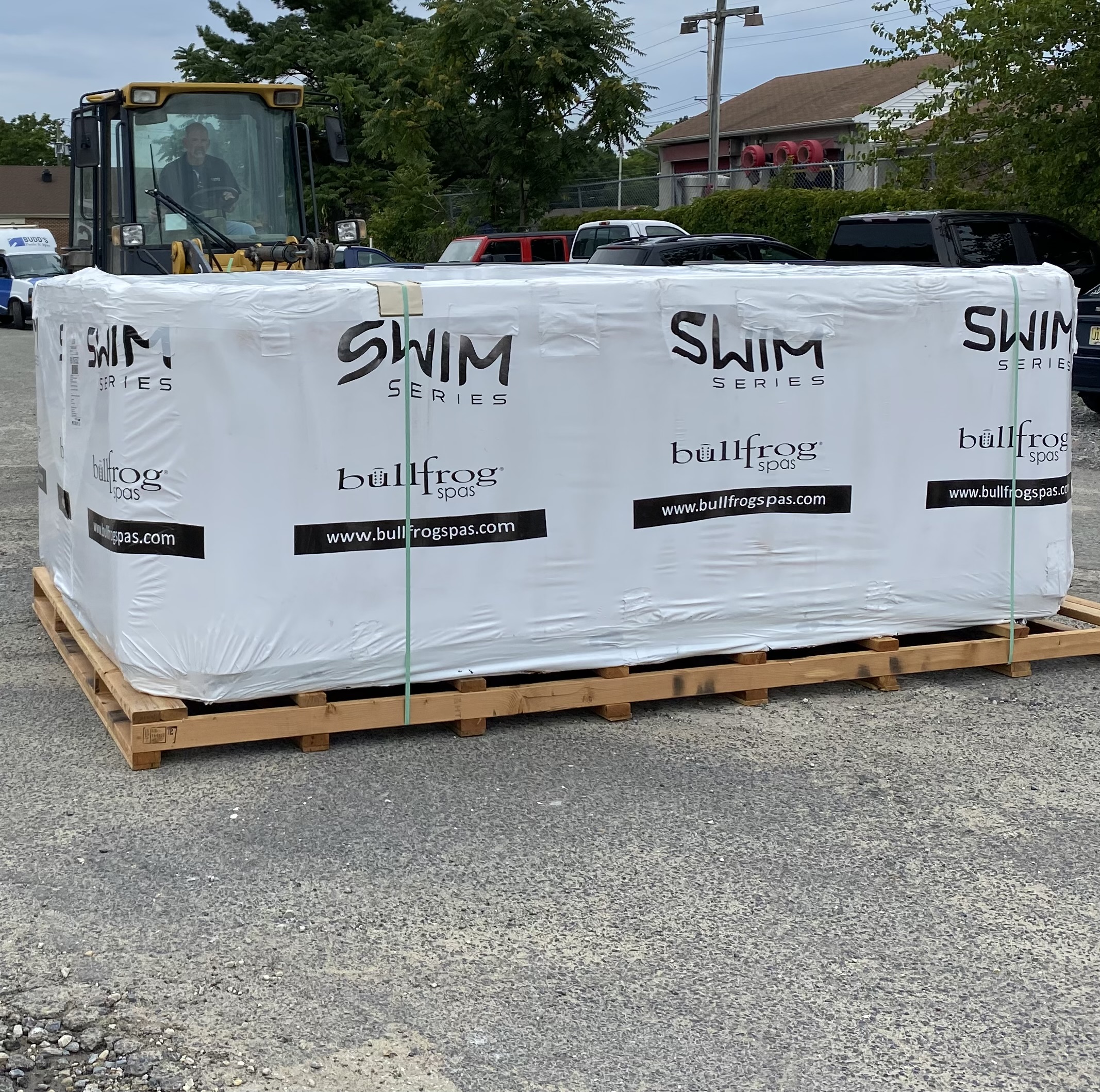
Bullfrog’s Supersized Swim Series Spas Arrive: Budd’s Pools & Spas recently took delivery of one of the first S150 Swim Series hot tubs by Bullfrog Spas
New ‘Swim Spas’ Offer Another Option
Bullfrog comes at the small pool idea from a different direction. Long a leader in luxury hot tubs, the company has launched a new Swim Series line that redefines what a hot tub can be. We recently took delivery of one of their first units, the 150 model, which is about 12 feet long. That will be followed by a larger 200 model (about 17 feet) to arrive this fall. Rumor has it a third model measuring 23 to 25 feet will soon follow.
Is Expert Pool Maintenance a Luxury?
Consider these 3 Risks before You Decide
Too many people buy an in-ground swimming pool and then treat paying for routine water and pool maintenance as if it were an optional luxury.
I’m in the luxury design/build pool business because—let’s face it—all in-ground pools are luxuries. Yet I see too many pool owners treat their sizable investment as if routine, technically proficient and timely maintenance of water, pool, and equipment were optional. As if it’s only required when something goes wrong, or routine pool maintenance can be done by a handyman, or any pool cleaning guy. Then there are those owners who really believe they can be their own pool handyman.

Focus First on Water Balance
Things go wrong fast when you let pool water get unbalanced, and summer heat can speed up the process at an alarming rate. Yet water maintenance is the task pool owners most frequently leave to unqualified parties or attempt to do themselves. Either way, inept or inexperienced water maintenance is bound to lead to expensive—even dangerous—consequences.
3 Risks Getting Pool Water Balance Wrong
The dangers of inadequate water maintenance are clear:
1. People who get in the water are at risk
2. All pool surfaces (vinyl, plaster, tile) and the structural integrity of underlying concrete are at risk
3. Vital pool functions (pump, filters, or anything in contact with pool water) are at risk
If you think a pool’s water is safe because it looks clear, read “Clear water, clean pool? Not necessarily.” If you think routine pool maintenance is a nice-to-have option, wait until you get the bill for repairing neglected pool surfaces. Or wait even longer and suffer the consequences of an unrepairable concrete structure. You may discover you have a white elephant that you can’t easily unload when you go to sell the property.
Maybe You Don’t Know What You Don’t Know
I know do-it-yourselfers who have the technical skills, time, and discipline to do pool water maintenance. Often, they enjoy the challenge. But there are far more DYI-ers who either don’t have the skill, or run out of time, and fall into the do-it-when-it’s convenient habit. They simply don’t know the risks they’re taking.
These “do it when I think of it” owners are among the last to admit they need help but the first to call in a panic when an emergency hits. Perhaps more self-destructive, are those who don’t recognize the deteriorating situation, until they’ve done permanent damage to their pools.
3 Things You Can Do to Maintain Safe Pool Water
- Find and listen to a trusted expert: Expert help is your first line of defense against making embarrassing or irreversible mistakes. You need someone who is a trained practitioner and knows your pool.
- Don’t just rely on Google answers and YouTube advice: It’s too easy to get wrong opinions, not enough information, or make the wrong assumptions in applying online information to your specific pool environment.
- Pay for the right help: Even if you’re sufficiently skilled and motivated to do your own work, you can’t rely on free advice from the busy tech analyzing your water sample. If you want to be sure you’re getting it right, be prepared to pay. Get a home consultation with a pool expert. Then check back regularly with your advisor. Things can change rapidly in pool water balance. Make sure you’re keeping up.
I encourage owners to learn as much as they can about maintaining their pools. Our technicians are always happy to share information with you when servicing your pool. I also strongly encourage you to relax. Leave time to enjoy your pool, not just work on your pool.
It’s Complicated Keeping Water Balanced
It’s a hard job keeping up with the chemistry of pool water balance and understanding LSI. At Budd’s Pools & Spas, we make continuous training of our construction teams, installers, and service technicians a top priority. We also share and continue adding more information about water maintenance in social media posts, at the Budd’s Pools website, and right here on The WaterSpace blog.
A Necessity that Can Feel Luxurious
So, here is the answer to the question, “is swimming pool maintenance a luxury?” Proper, routine pool maintenance is a necessity, and keeping pool water balanced is never optional, never a job to be taken lightly.
With the right help, you can make the results of routine pool maintenance feel luxurious. You’ve enhanced your safety. You’ve gained peace of mind. Now you can simply enjoy the luxurious feeling your pool was designed to provide.
5 Steps to Make a Swimming Pool a Luxury Pool
How do you achieve that ultimate value—the luxury pool effect. In previous articles we’ve looked at the well documented benefits—physical, mental, social and spiritual—that water and swimming pools bring into a home. These health benefits—along with the fun, relaxation, and enjoyment—can add up to what I call a “Luxury Pool Effect.”
The feel of luxury is subjective, different for each of us and experienced differently from one moment to the next. The one thing we can count on is that—consciously or unconsciously—when we step into an outdoor space filled with water, our minds and bodies are drawn to its luxury effect. It doesn’t matter if you’re in the water or gathered around the water, a well-designed swimming pool and its surrounding environment conveys a sense of luxury.
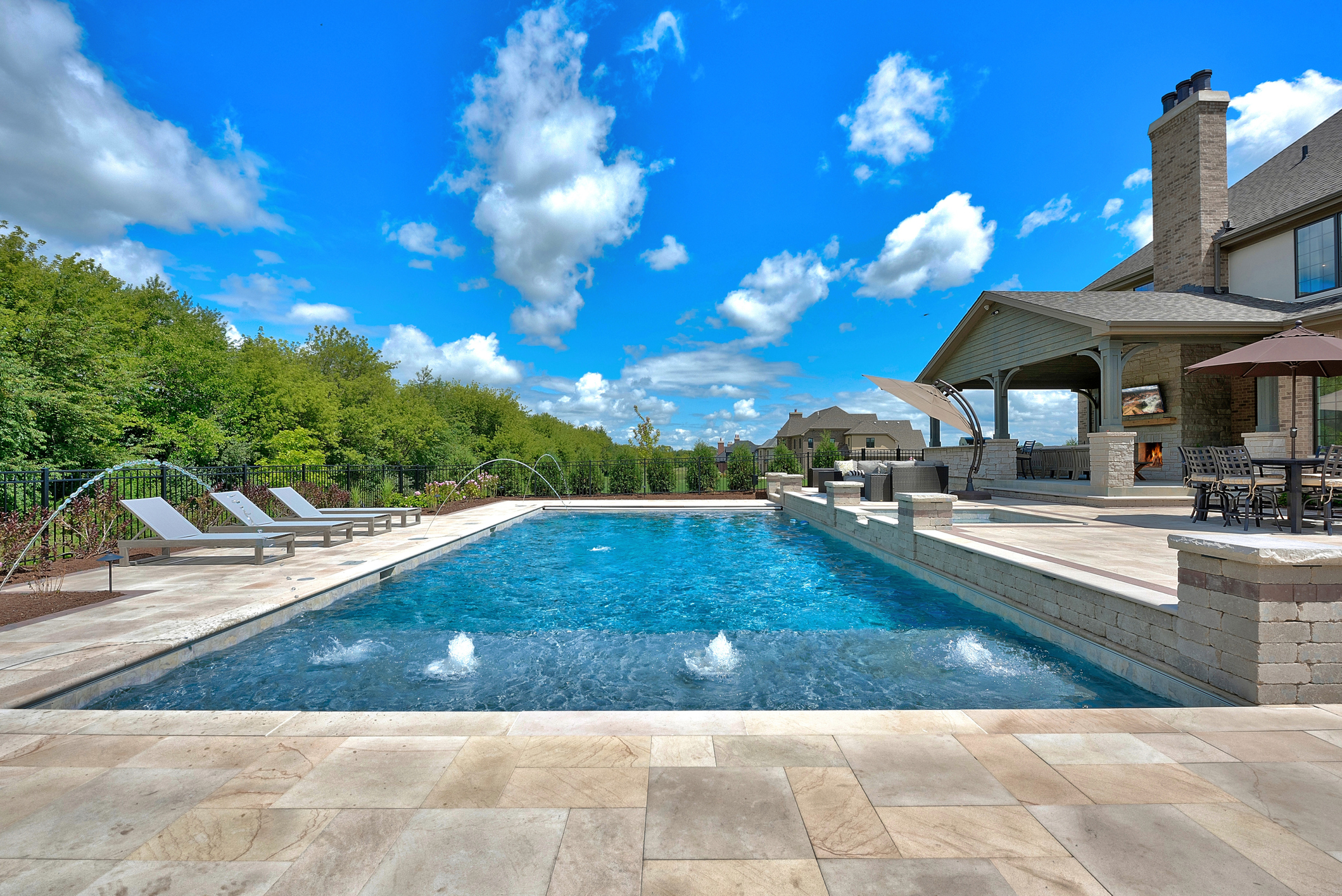
A well-designed swimming pool and its surrounding environment conveys a sense of luxury
5 Steps to Value and Luxury
How do some pool owners achieve that ultimate value—the luxury pool effect—while others don’t? The answer isn’t simply spending more money. Look for “value luxury.” The secret is luxury that adds value to your home and value to the way you experience your home. Successful pool projects start with choosing a quality pool design/build firm that follows these five essential steps.
(1) Design:
Creating luxury starts with good design, and good design starts with a plan that takes the project from concept to a comprehensive design with full construction documentation. The initial plan answers a host of key questions: The size and shape of your yard and environmental conditions, such as soil, shade, sun, view. How you plan to use the pool. The size and style of your pool, and additional features that complete the plan. Colors are chosen and designs developed to fit in with your home. Movement through your outdoor space is carefully choreographed.
(2) Focus:
What you leave out of a design is as important as what you put in. Sometimes a pool design is constrained by budget, local building codes, lot size, shape, or soil conditions. When you boil down your plan to the essential elements it can feel like you’re sacrificing something, but in the long run less is more. There’s luxury in open spaces, in allowing room for focus, contrast and balance.
(3) Engineer:
Creating luxury that lasts is a design and engineering process. Before you start a pool design an environmental engineer may need to evaluate the site for soil conditions. These findings can influence design choices, such as grading and drainage, engineering of patios and structures. Engineering enters into proper sizing of piping, choosing and integrating pumps, filters, water treatment systems, heaters, and other features into a pool design. To ensure structural integrity of your pool, an engineer is onsite during construction to test and certify the durability of the concrete.
(4) Build:
Building luxury that lasts means your builder is onsite to oversee and coordinate your pool construction through the entire process. Your builder sees that piping is installed correctly, and rebar is installed to specifications. Your builder will make sure all concrete meets specs and concrete delivery is timed right. That work is performed as specified and crafted with care. That disruption and impact on the surrounding grounds are minimized.
(5) Maintain:
Maintaining luxury that lasts means your pool is designed and built with maintenance in mind. It means your builder is available to service your pool. Competent service requires sharing important knowledge about testing and water balance with pool owners. Maintainability means trained service technicians who are constantly upgrading their skills. That’s how you enjoy what you’ve created for years to come.
Value Luxury
I didn’t set out to build luxury pools. My goal has always been to design and build pools and spas that people simply enjoy. What I discovered is that our designs were creating these outdoor living areas—these WaterSpaces—that helped home owners uncover more value in their yards and homes. Everything just feels more luxurious.
Together we transform your home. With great design, careful and competent construction, and continuing maintenance your new pool adds remarkable underlying value: the luxury effect. As a client once told me, “Every time I enter this space, or simply look out at it, I feel refreshed. It’s something I’ll always value.”
LSI and Pool Water Balance Made Easier
Water balance starts with understanding LSI: the Langelier Saturation Index. I admit I’m a nut about maintaining safe and clean pool water. I know how important it is to maintain water that’s good for your pool and for the people in it. What drives me nuts is that it doesn’t have to be so complicated. You just need to know why and how to keep your balance.
Water balance gets complicated, if you let it
Too many people who are supposed to be responsible for the job think that using LSI is too complicated, that it’s easier to throw more chemicals in the water. They simply don’t understand how LSI helps keep things balanced, using fewer chemicals. Here’s the truth:
- Water balance gets complicated when you don’t do anything about it
- Water balance gets complicated when you do the wrong things
- Water balance gets complicated when you get bad information on YouTube
Watch these videos about LSI, get the free app, and make maintaining your pool water far less complicated.
Whether you’re a responsible do-it-yourself pool owner, or you rely on a pool service, arm yourself with the right information about LSI. Then get the free app that makes it easier to determine the right moves to maintain your water balance. The first two-minute video explains LSI and the second shows how to use a free app. Both videos are produced by Orenda Technologies, as is the app. Orenda is to my mind the leading specialty chemical manufacturer—and educator—serving the pool industry. I think you’ll see why in these videos.
Why Measure LSI:
In this Understanding LSI video, Orenda Technologies’s Eric Knight explains why LSI is the first and most important step in pool water maintenance
Download the App, Watch the Video:
Download ORENDA in the App Store or GooglePlay then watch How to use the Orenda App and LSI Calculator. Eric Knight shows how the App’s highly accurate LSI calculator helps you adjust the water balance factors to get your LSI value as close to 0.00 as possible.
Know who you can trust
The problem of getting water balance right isn’t just a matter of unknowing or negligent owners—commercial or residential. It goes deeper to those who sell their services and pose as experts online. Too many pool services people either don’t understand or don’t want to be bothered with the time and effort to use the water testing and treatment tools available today. For DYI owners, finding trustworthy information can be a problem. You might click on the most popular link and miss the right link. The one that takes you to what you really need to know about water chemistry.
There’s more to learn
We all have more to learn about water. Eric Knight, who you saw in these videos, will be conducting a training session here in Deptford, NJ, for all our technicians. If you’ve engaged Budd’s Pools to manage your pool water maintenance, we’ll help you learn more as well. With the right information and tools, it’s easier for everyone to understand what to do, when, and why. It’s all about balance and keeping your pool water chemistry less complicated.
Following is a short list of articles about water maintenance that we’ve posted on The WaterSpace.
- Clear water, clean pool? Not necessarily
- How Water Balance Makes for Safer Stay-at-Home Swimming
- Good Health News on Swimming at Home, But Keep Testing Your Water’s Safety
I also recommend the Orenda Thechnologies blog, and their catalog of educational videos.
Is It a Spa or Hot Tub, or Maybe an Ahhhhh Tub?
Do you know when to call it a spa or hot tub? For a long time the words were used interchangeably, but now there’s a clear difference: Hot Tubs are manufactured and free-standing. Spas are custom built and in-ground—often part of a larger pool project.
Hot tubs started life as a round, wood vat that holds hot water for people to soak in. The spa differentiated itself with water jets that make warm water feel even better.
But then hot tubs began to offer jets and were made of longer lasting materials. In those early days, Bull Frog Spas, our choice of the top-end hot tub manufacturers, adopted the spas name because their focus is on engineering the industry’s best water jet systems.
Today, Bull Frog and others in the industry have largely embraced the hot tub designation. At Budd’s Pools & Spas we offer both custom in-ground spas and Bull Frog’s luxury free-standing hot tubs. Whichever you choose from Budd’s— spa or hot tub—when you sink into its warm waters, you may be calling it the Ahhhhh Tub.
spa or hot tub?
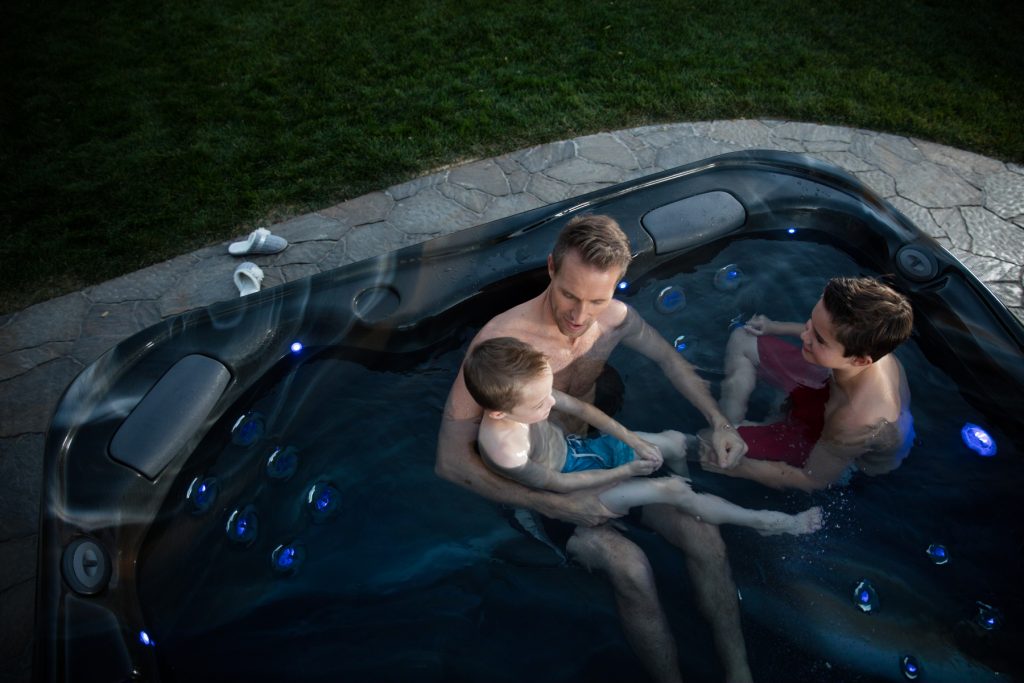
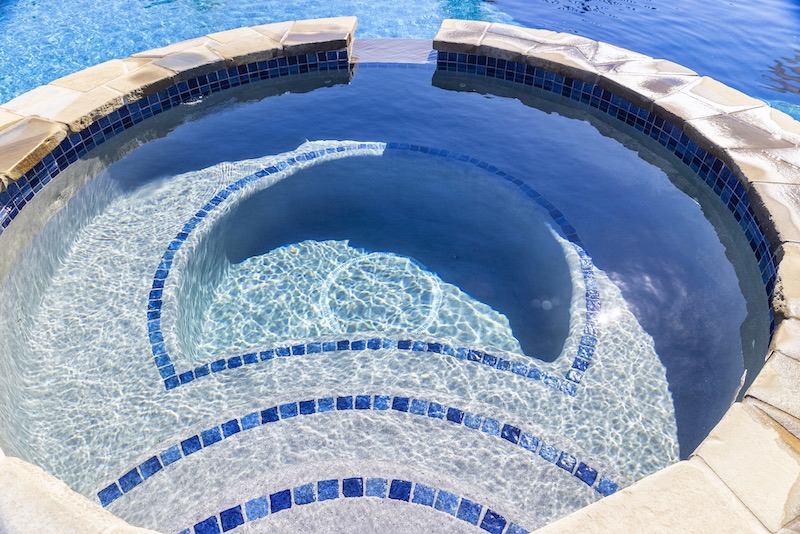
We Need to Talk about Pool Construction
It’s time we had a serious conversation about pool construction. We’ve been focused for some time here at the WaterSpace blog on the elements and principles of pool design because that’s the place where you need to start. We started there because design is a topic too many new pool buyers—as well as cookie-cutter pool builders—skip over, and that’s a shame. If you haven’t yet visited our pool design series, take time to do so before you start your own pool project. You’ll come away with a clearer understanding of good design and some useful tools for getting the most value and enjoyment from your new pool investment.
The next step beyond design in your journey as a new pool buyer is all about pool construction, concrete chemistry, contractor competence, and how to spot unskilled or dishonest construction practices. Over my years in the pool business, I’ve seen too many swimming pools in need of costly concrete repairs—even pools beyond repair. You don’t want to become one of those unhappy homeowners facing costly problems because the construction didn’t meet the pool industry’s highest standards. Many of those problems start with the concrete, and so concrete will be the first topic we focus on in this series.
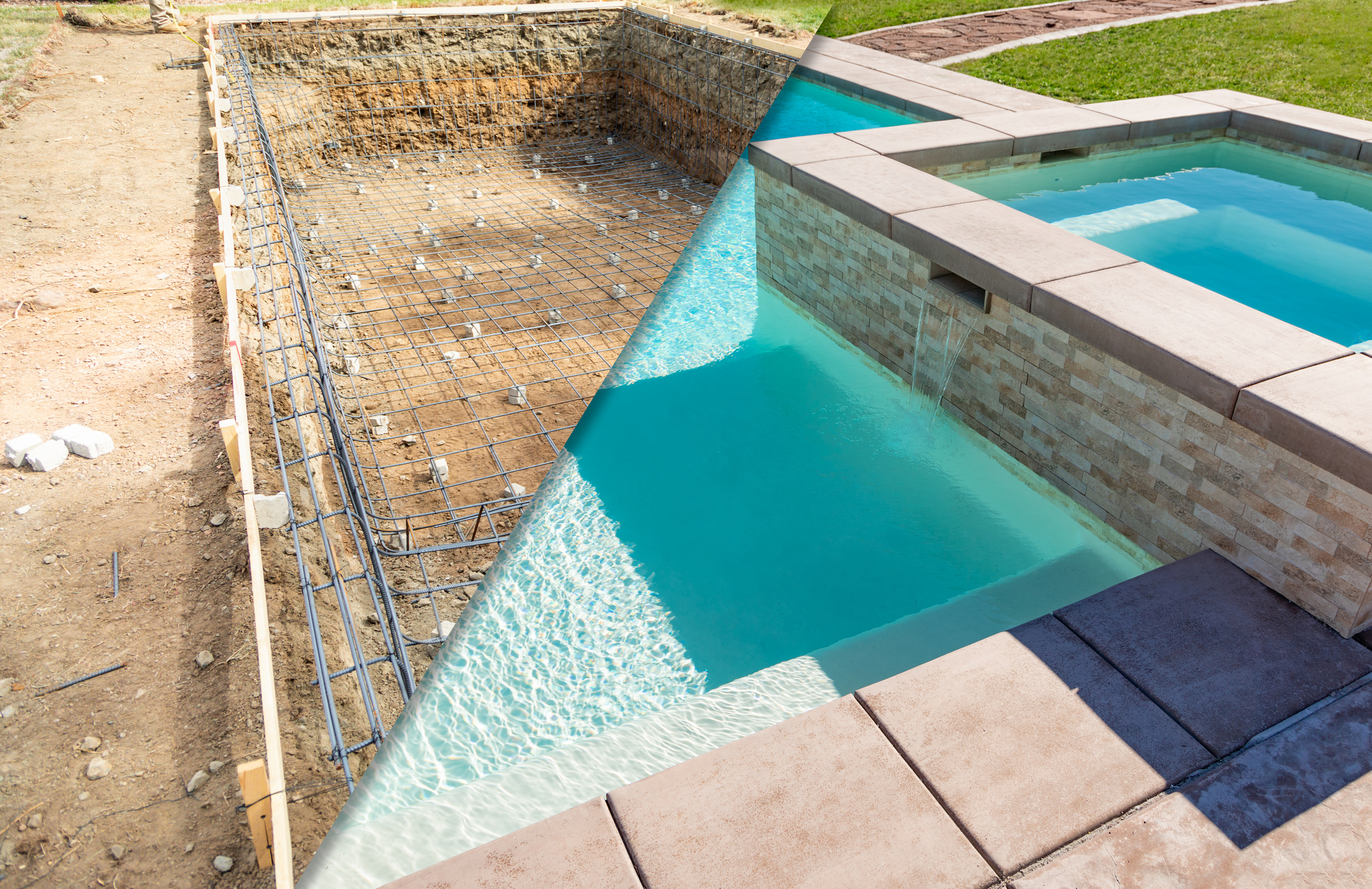
Budd’s Pools only uses shotcrete—not gunite—for its custom pools.
Why an in-ground, steel reinforced concrete pool is your best value
Strength is the reason you want an in-ground pool built with steel reinforced concrete. You pay more now for its strength, durability, and longevity, and you enjoy your pool more for a longer time. And if you ever decide to sell your home and move, you’ve got an asset in your yard that adds value, rather than a hole in the ground that’s a liability.
However, to realize that value, you want to find a trustworthy builder whose concrete work follows all the procedures, based on the science, and meets or exceeds the pool industry’s highest standards. If you aren’t armed with an understanding of pool construction, your top criteria may default to the lowest bid. That’s a risky path to take when there’s so many things that can go wrong in pool construction.
Let’s dig deeper into how good pools get built
So, roll up your sleeves, get prepared to get your hands dirty, and dig deeper with me into how in-ground pools are supposed to be built. We’ll start the series with concrete construction. This is the material that forms the vessel that holds your pool water. Done right, concrete makes the strongest pool structure, the one that will last for many years to come.
In the next article we will start a journey through the construction of a custom shotcrete pool. We’ll show you why Budd’s Pools only uses shotcrete—not gunite—for its custom pools. We’ll talk about concrete construction standards and why Budd’s Pools are built to exceed pool industry standards. I promise you won’t find this story as dry as concrete. In fact, you’ll learn—among other things—why keeping concrete wet enough during the critical 30-day drying process is the secret to make pools strong and long lasting.
Connect the Dots to Achieve Unity in Your Landscape Design
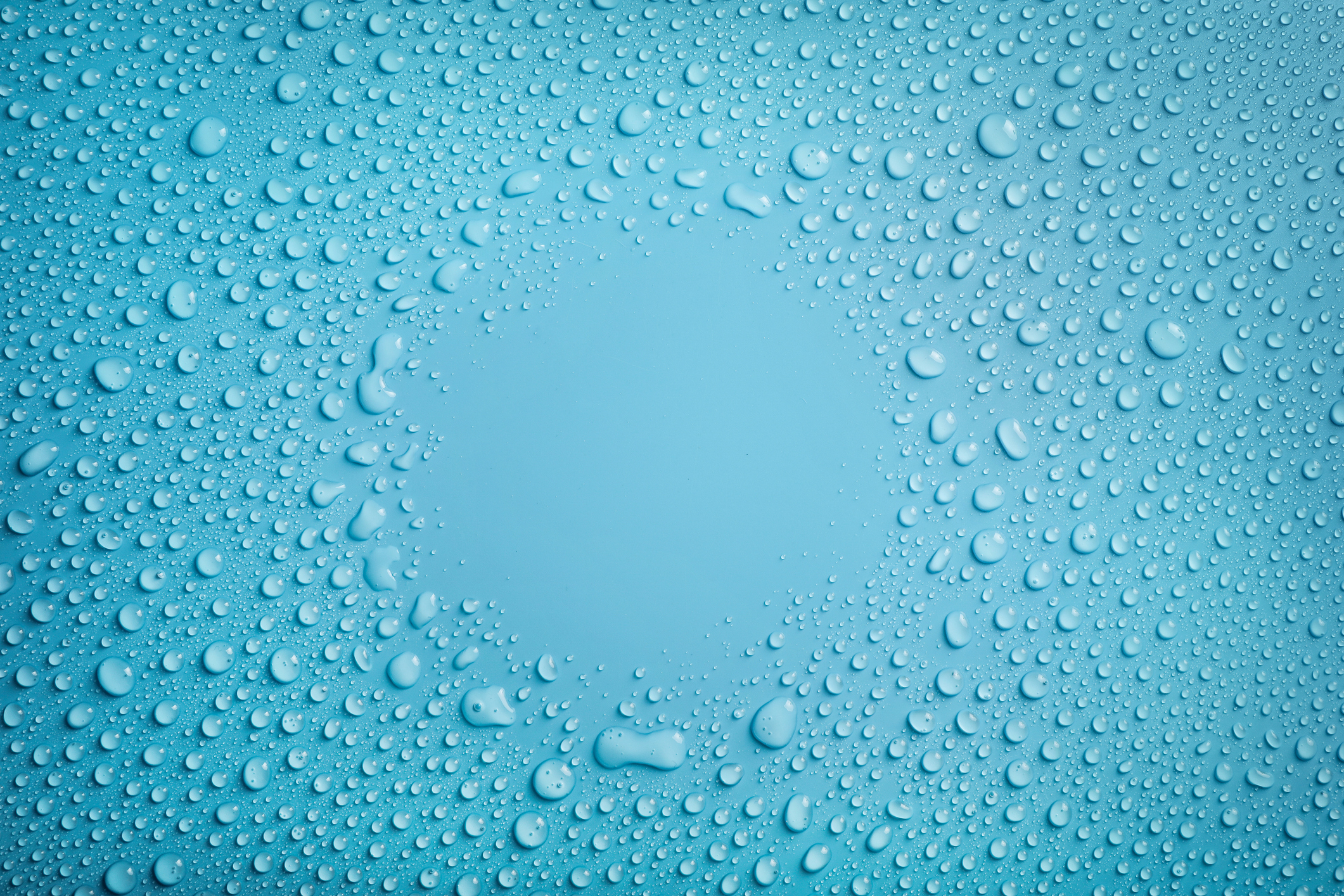
This 6th principle of landscape architecture poses a question you need to ask early and often.
The Principle of Unity can seem terribly abstract, but it’s really one simple question: Did you connect all the dots in your design?
How does your design hang together?
This is the question you don’t want to start asking after everything is built, installed, and planted. It’s the question you and your designer have to ask and answer and ask again through every step of your plan.
Your mind senses Unity, seeks out environments that feel unified—an harmonious, well designed space where all the Elements of Design work together. You’ll know when your plan has achieved Unity. Your guests will feel the Unity, too, or sense its absence. People feel uncomfortable in a space where Unity is missing. They may not consciously see every design flaw, but they feel them.
Follow the principles
If you want the result to hang together, look for Unity as you follow each of the Principles of Design. You can learn more about the first five Principles in these articles:
- Balance: You can’t stand erect without balance, and you can’t stand an environment that’s off balance
- Contrast: Artful, lively contrast makes your outdoor environment more interesting and counters boredom of too much balance
- Emphasis: Draw attention, set the stage, provide focus, create a layered experience for people to move through your space
- Rhythm: Bring order, set the tempo, and harmonize everyone’s moment through your space
- Movement: Movement is flow, flow is life, and unity is a measure of how well your design brings feelings of positive flow and life together
Some design principles can sometimes work against Unity. For example, high Contrast or over-the-top Emphasis, if not handled with skill, can break unity. Done well, you can use high contrast to add excitement and drama. Place strong emphasis on a feature worthy of focus, and you’ll add applause-worthy interest to your space. Done without care and purpose, too much contrast, or the wrong emphasis, and the result feels disorganized, even chaotic.
Who needs Unity? Everyone in Every Space
Unity isn’t just a principle for large properties or big budgets. It applies equally to small and big spaces, large and small budgets. In fact, smaller spaces and smaller budgets often present special challenges where creative design makes a decisive difference in the results.
Amy Fedele is a Philadelphia area graphic designer, who turned her new (first) home into a DIY laboratory of landscape design, shares everything she learns on her blog. In her article, “5 ways to create unity and flow in your landscape,” she says one of the most common problems she sees, “is the lack of connection from one part of the garden to another.”
Whatever you budget, when you make the connections, you get more satisfaction from your investment and a lot more pleasure every time you enter your space. Whether it’s a simple garden around your hot tub, or a landscaped patio surrounding your new pool, your plan should unify your home and outdoor architecture. Start with paths from home to the things your yard holds. These are visual and physical paths—to patio, to pool, to spa, to fire pit, to garden, or to an especially important feature.
Unity in flow means designs that direct the movement of eyes and bodies through your space. Create those places to start. Points to slow down. Features that invite you to pause, to rest or play, exercise or meditate, read a book, or dine with friends and family. When you design for Unity, you get positive flow. Unity creates purposeful movement. It connects the dots and invites you and your guests to simply enjoy your outdoor space.
Design for Movement in Your Outdoor Living Space
Eyes move, minds move, and people enter the flow of space.
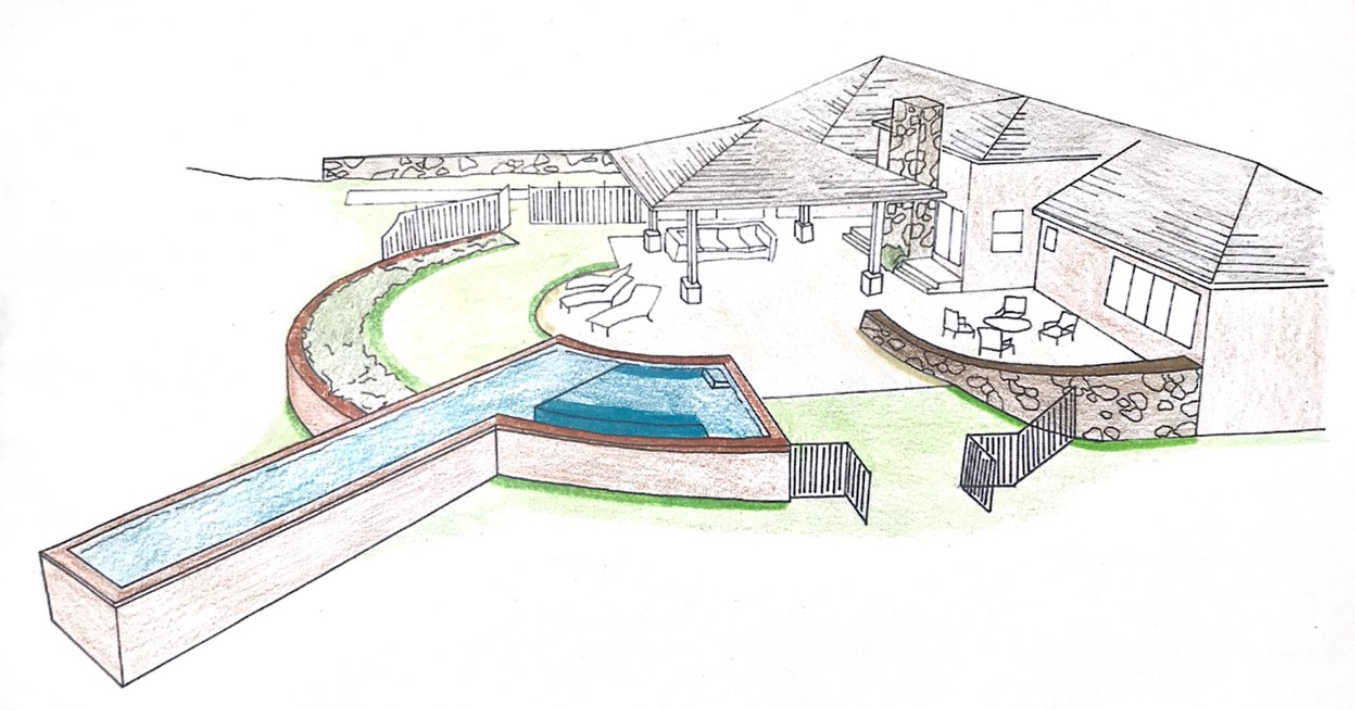
Architectural lines move minds and bodies: The rendering above illustrates how straight lines, curves and angles create a sense of movement in our minds. The dramatic lines of the lap pool show how lines create a shape that invites our bodies to join in the movement
Pools, buildings, and landscapes seem so firmly anchored to the earth that Movement—the fifth of our Six Principles of landscape and architectural design—can be hard to comprehend. Even when you don’t consciously see architectural movement, however, you’ll sense its presence, and you’ll likely find yourself getting bored if a design lacks movement.
In “The expression of movement in architecture,” (The Journal of Architecture Volume 16 Number 4, published 2011), Adam Hardy describes how built places are filled with allusions to movement: “sun and shade play across the walls,” he says, and “the breeze wafts through” a space. Sometimes, he adds, things actually move, as when “foundations settle.”
In most cases, Hardy says, “it’s not the architecture” that’s moving but the mind’s perception: “A staircase rises… a corridor snakes, a spire soars. Everybody knows, of course, that they all stay still: it is the eye and the mind that rise or run.”
People need movement
Make water move and people feel the movement. Add a lap lane (or lap line) to your pool, and people are more likely to swim. But even sitting still, people look for movement. When you think about and plan for movement in design, you’re paying attention to how people will feel, act and react in your space.
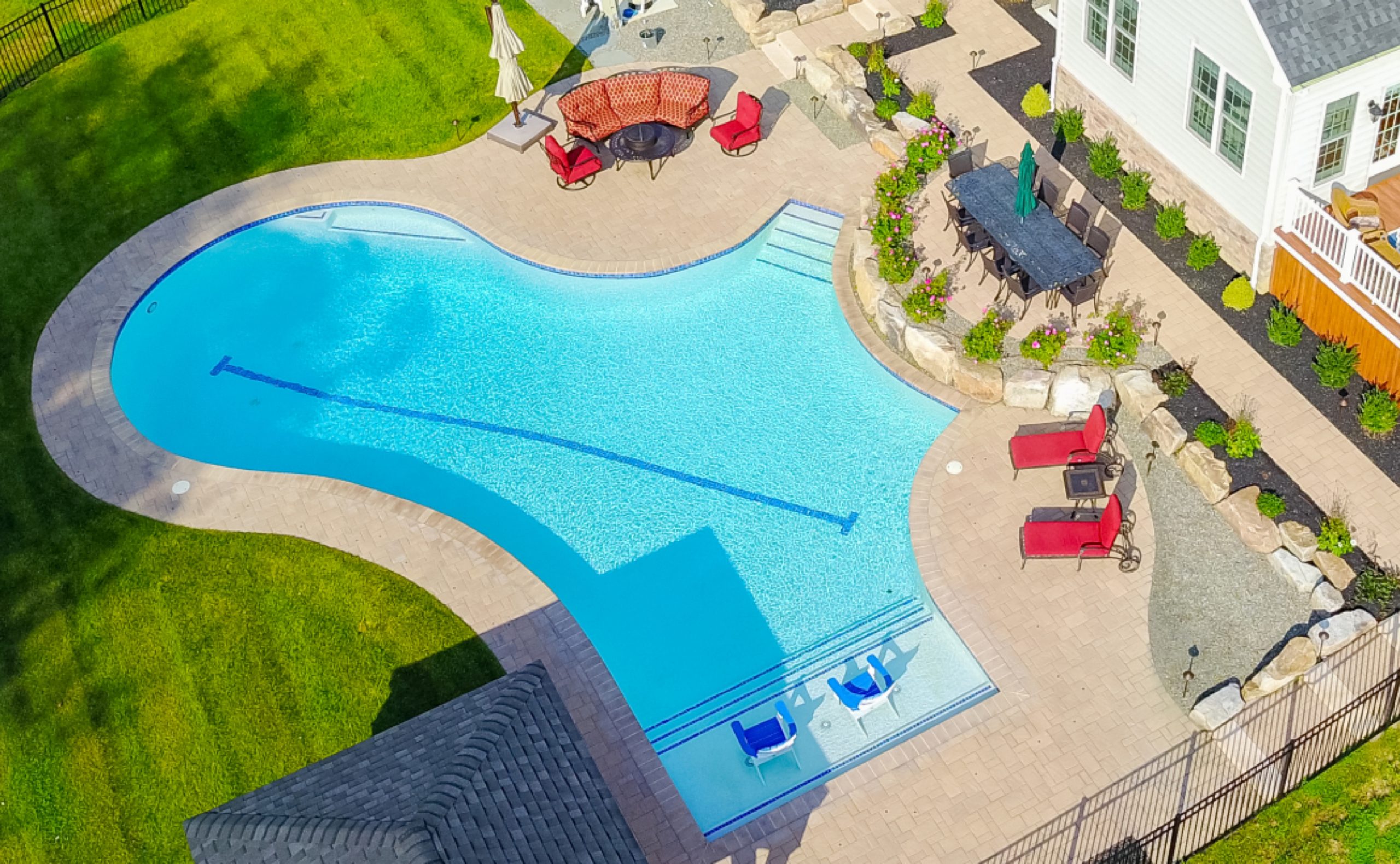
A single line helps us get physical, turning this informal curvilinear pool into a swimmer’s lap lane.
Movement In and Through Space
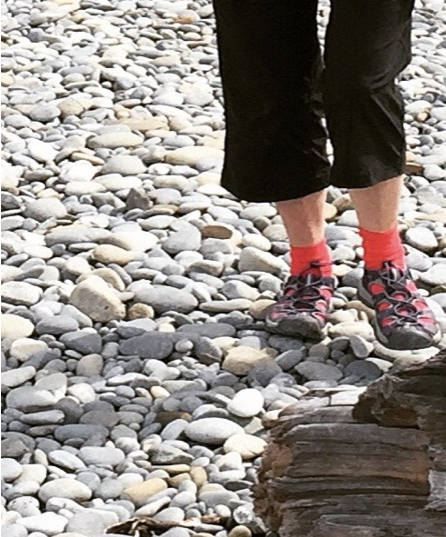
Move slow: Stones slow your pace and your gaze.
A lap lane is like a path in water. Designs with movement also create paths and patterns in our minds. Movement prompts people to look in a certain direction and perhaps move in a certain way. Some design features, like the lap lane, literally move us:
◦ Down a path leading to a pool, spa, garden, or other feature
◦ Along a line of trees, bushes or low plants that direct us through a space
◦ Through an arch, columns, or a doorway that opens onto a view we want to visit
Lines, Textures and Movement
Eyes follow Movement the way feet follow paths. Your eyes move along a line until you see an end point. Like walking along a path, your eyes move faster when the line is straight. Your gaze slows a bit when you encounter a slight angle or gentle curve and slows more for a long or sharp curve.
In landscapes, plants can direct eye movement and help define lines. Low and rounded plants prompt your eye follow a line. A taller tree or shrub placed along the line will cause your eyes to pause or stop.
Just as texture underfoot affects our speed along a path, the texture and colors of plants and building materials affect how quickly our eyes travel along a visual path. Smooth surfaces move eyes faster. The rougher the texture, the slower the pace for eyes and feet.
Movement engages all our senses

Step by step: Steppingstones direct you along a path. When crossing water as above, you may find yourself feeling your way along.
“So much of how we perceive the world is unconscious,” Nina Kraus writes in “Of Sound Mind: How Our Brain Constructs a Meaningful Sonic World.”
Krause explains how hearing developed out of the need to sense movement. “The ear arose,” she says, “from organs designed to perceive gravity and an organism’s place in space with the goal of achieving movement.”
As Krause points out, simply listening to speech “activates the motor cortex as well as our own speaking muscles. Just listening to rhythm patterns or piano melodies activates the brain’s motor system.”
The same could be said of the movement, rhythm and patterns created in our designed spaces.
We may not be aware of just how much our senses are engaged when see, hear or feel movement. But the effects of movement created by design are real. Designing for movement is an essential part of what people perceive and how they react in a built space.
As we described in our discussion of the Blue Mind, there is something about water that draws us to it. And when it’s moving water—a gentle trickle of a small fountain, a rushing stream, an ocean tide, or a powerful waterfall—our attention turns to feelings ranging from peace to awe to joy. That’s the goal of the WaterSpaces we build: for you to simply enjoy.

